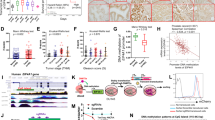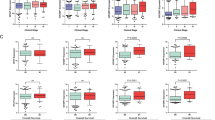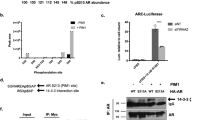Abstract
The Polycomb group transcriptional repressor Bmi-1 often overexpressed and participated in stem cells self-renewal and tumorigenesis initiating of prostate cancer. In this progression, Bmi-1 protein was regulated by transcription and post-translational modifications (PTMs). Nobly, the underlying PTMs regulation of Bmi-1 is poorly known. Here we use co-immunoprecipitation show that in C4-2 cell line, Bmi-1 directly interacted with OGT which is the only known enzyme catalyzed the O-GlcNAcylation in human. Furthermore, we identified that Ser255 is the site for Bmi-1 O-GlcNAcylation, and O-GlcNAcylation promoted Bmi-1 protein stability and its oncogenic activity. Finally, microarray analysis has characterized potential oncogenes associated pathway subject to repression via the OGT-Bmi-1 axis. Taken together, these results indicate that OGT-mediated O-GlcNAcylation at Ser255 stabilizes Bmi-1 and hence inhibits the TP53, PTEN and CDKN1A/CDKN2A pathway. The study not only uncovers a novel functional PTMs of Bmi-1 but also reveals a unique oncogenic role of O-GlcNAcylation in prostate cancer.
This is a preview of subscription content, access via your institution
Access options
Subscribe to this journal
Receive 50 print issues and online access
$259.00 per year
only $5.18 per issue
Buy this article
- Purchase on Springer Link
- Instant access to full article PDF
Prices may be subject to local taxes which are calculated during checkout










Similar content being viewed by others
References
Lukacs RU, Memarzadeh S, Wu H, Witte ON . Bmi-1 is a crucial regulator of prostate stem cell self-renewal and malignant transformation. Cell Stem Cell 2010; 7: 682–693.
Robinson D, Van Allen EM, Wu YM, Schultz N, Lonigro RJ, Mosquera JM et al. Integrative clinical genomics of advanced prostate cancer. Cell 2015; 161: 1215–1228.
Attard G, Parker C, Eeles RA, Schroder F, Tomlins SA, Tannock I et al. Prostate cancer. Lancet 2016; 387: 70–82.
Barlow LJ, Shen MM . SnapShot: Prostate cancer. Cancer Cell 2013; 24: 400.e1.
Dardenne E, Beltran H, Benelli M, Gayvert K, Berger A, Puca L et al. N-Myc Induces an EZH2-Mediated Transcriptional Program Driving Neuroendocrine Prostate Cancer. Cancer Cell 2016; 30: 563–577.
Gu L, Frommel SC, Oakes CC, Simon R, Grupp K, Gerig CY et al. BAZ2A (TIP5) is involved in epigenetic alterations in prostate cancer and its overexpression predicts disease recurrence. Nat Genet 2015; 47: 22–30.
Itkonen HM, Minner S, Guldvik IJ, Sandmann MJ, Tsourlakis MC, Berge V et al. O-GlcNAc transferase integrates metabolic pathways to regulate the stability of c-MYC in human prostate cancer cells. Cancer Res 2013; 73: 5277–5287.
Cao L, Bombard J, Cintron K, Sheedy J, Weetall ML, Davis TW . BMI1 as a novel target for drug discovery in cancer. J Cell Biochem 2011; 112: 2729–2741.
Bansal N, Bartucci M, Yusuff S, Davis S, Flaherty K, Huselid E et al. BMI-1 targeting interferes with patient-derived tumor-initiating cell survival and tumor growth in prostate cancer. Clin Cancer Res 2016; 22: 6176–6191.
Yoo YA, Roh M, Naseem AF, Lysy B, Desouki MM, Unno K et al. Bmi1 marks distinct castration-resistant luminal progenitor cells competent for prostate regeneration and tumour initiation. Nat Commun 2016; 7: 12943.
Malik R, Lenobel R, Santamaria A, Ries A, Nigg EA, Korner R . Quantitative analysis of the human spindle phosphoproteome at distinct mitotic stages. J Proteome Res 2009; 8: 4553–4563.
Voncken JW, Schweizer D, Aagaard L, Sattler L, Jantsch MF, van Lohuizen M . Chromatin-association of the Polycomb group protein BMI1 is cell cycle-regulated and correlates with its phosphorylation status. J Cell Sci 1999; 112 (Pt 24): 4627–4639.
Voncken JW, Niessen H, Neufeld B, Rennefahrt U, Dahlmans V, Kubben N et al. MAPKAP kinase 3 pK phosphorylates and regulates chromatin association of the polycomb group protein Bmi1. J Biol Chem 2005; 280: 5178–5187.
Moon JH, Heo JS, Kim JS, Jun EK, Lee JH, Kim A et al. Reprogramming fibroblasts into induced pluripotent stem cells with Bmi1. Cell Res 2011; 21: 1305–1315.
Hu P, Shimoji S, Hart GW . Site-specific interplay between O-GlcNAcylation and phosphorylation in cellular regulation. FEBS Lett 2010; 584: 2526–2538.
Chu CS, Lo PW, Yeh YH, Hsu PH, Peng SH, Teng YC et al. O-GlcNAcylation regulates EZH2 protein stability and function. Proc Natl Acad Sci USA 2014; 111: 1355–1360.
Slawson C, Hart GW . O-GlcNAc signalling: implications for cancer cell biology. Nat Rev Cancer 2011; 11: 678–684.
Gambetta MC, Muller J . A critical perspective of the diverse roles of O-GlcNAc transferase in chromatin. Chromosoma 2015; 124: 429–442.
Butkinaree C, Park K, Hart GW . O-linked beta-N-acetylglucosamine (O-GlcNAc): Extensive crosstalk with phosphorylation to regulate signaling and transcription in response to nutrients and stress. Biochim Biophys Acta 2010; 1800: 96–106.
Schimpl M, Schuttelkopf AW, Borodkin VS, van Aalten DM . Human OGA binds substrates in a conserved peptide recognition groove. Biochem J 2010; 432: 1–7.
Bauer C, Gobel K, Nagaraj N, Colantuoni C, Wang M, Muller U et al. Phosphorylation of TET proteins is regulated via O-GlcNAcylation by the O-linked N-acetylglucosamine transferase (OGT). J Biol Chem 2015; 290: 4801–4812.
Ito R, Katsura S, Shimada H, Tsuchiya H, Hada M, Okumura T et al. TET3-OGT interaction increases the stability and the presence of OGT in chromatin. Genes Cells 2014; 19: 52–65.
Iyer SP, Hart GW . Roles of the tetratricopeptide repeat domain in O-GlcNAc transferase targeting and protein substrate specificity. J Biol Chem 2003; 278: 24608–24616.
Iyer SP, Akimoto Y, Hart GW . Identification and cloning of a novel family of coiled-coil domain proteins that interact with O-GlcNAc transferase. J Biol Chem 2003; 278: 5399–5409.
Gambetta MC, Oktaba K, Muller J . Essential role of the glycosyltransferase sxc/Ogt in polycomb repression. Science 2009; 325: 93–96.
Sinclair DA, Syrzycka M, Macauley MS, Rastgardani T, Komljenovic I, Vocadlo DJ et al. Drosophila O-GlcNAc transferase (OGT) is encoded by the Polycomb group (PcG) gene, super sex combs (sxc). Proc Natl Acad Sci USA 2009; 106: 13427–13432.
Zhang F, Su K, Yang X, Bowe DB, Paterson AJ, Kudlow JE . O-GlcNAc modification is an endogenous inhibitor of the proteasome. Cell 2003; 115: 715–725.
Yadav AK, Sahasrabuddhe AA, Dimri M, Bommi PV, Sainger R, Dimri GP . Deletion analysis of BMI1 oncoprotein identifies its negative regulatory domain. Mol Cancer 2010; 9: 158.
Meng S, Luo M, Sun H, Yu X, Shen M, Zhang Q et al. Identification and characterization of Bmi-1-responding element within the human p16 promoter. J Biol Chem 2010; 285: 33219–33229.
Xie X, Piao L, Cavey GS, Old M, Teknos TN, Mapp AK et al. Phosphorylation of Nanog is essential to regulate Bmi1 and promote tumorigenesis. Oncogene 2014; 33: 2040–2052.
Nacerddine K, Beaudry JB, Ginjala V, Westerman B, Mattiroli F, Song JY et al. Akt-mediated phosphorylation of Bmi1 modulates its oncogenic potential, E3 ligase activity, and DNA damage repair activity in mouse prostate cancer. J Clin Invest 2012; 122: 1920–1932.
Li DW, Tang HM, Fan JW, Yan DW, Zhou CZ, Li SX et al. Expression level of Bmi-1 oncoprotein is associated with progression and prognosis in colon cancer. J Cancer Res Clin Oncol 2010; 136: 997–1006.
Liu L, Andrews LG, Tollefsbol TO . Loss of the human polycomb group protein BMI1 promotes cancer-specific cell death. Oncogene 2006; 25: 4370–4375.
Silva J, Garcia JM, Pena C, Garcia V, Dominguez G, Suarez D et al. Implication of polycomb members Bmi-1, Mel-18, and Hpc-2 in the regulation of p16INK4a, p14ARF, h-TERT, and c-Myc expression in primary breast carcinomas. Clin Cancer Res 2006; 12: 6929–6936.
Bommi PV, Dimri M, Sahasrabuddhe AA, Khandekar J, Dimri GP . The polycomb group protein BMI1 is a transcriptional target of HDAC inhibitors. Cell Cycle 2010; 9: 2663–2673.
Dean M . ABC transporters, drug resistance, and cancer stem cells. J Mammary Gland Biol Neoplasia 2009; 14: 3–9.
Wu J, Hu D, Yang G, Zhou J, Yang C, Gao Y et al. Down-regulation of BMI-1 cooperates with artemisinin on growth inhibition of nasopharyngeal carcinoma cells. J Cell Biochem 2011; 112: 1938–1948.
Author information
Authors and Affiliations
Corresponding author
Ethics declarations
Competing interests
The authors declare no conflict of interest.
Additional information
Supplementary Information accompanies this paper on the Oncogene website
Rights and permissions
About this article
Cite this article
Li, Y., Wang, L., Liu, J. et al. O-GlcNAcylation modulates Bmi-1 protein stability and potential oncogenic function in prostate cancer. Oncogene 36, 6293–6305 (2017). https://doi.org/10.1038/onc.2017.223
Received:
Revised:
Accepted:
Published:
Issue Date:
DOI: https://doi.org/10.1038/onc.2017.223
This article is cited by
-
MUC4 O-GlcNAcylation Regulates the Epithelial Phenotype in Conjunctival Epithelial Cells
Biochemical Genetics (2024)
-
O-GlcNAcylation: the sweet side of epigenetics
Epigenetics & Chromatin (2023)
-
Reciprocal regulation of TWIST1 and OGT determines the decitabine efficacy in MDS/AML
Cell Communication and Signaling (2023)
-
O-GlcNAcylation: an important post-translational modification and a potential therapeutic target for cancer therapy
Molecular Medicine (2022)
-
GIPC2 interacts with Fzd7 to promote prostate cancer metastasis by activating WNT signaling
Oncogene (2022)



